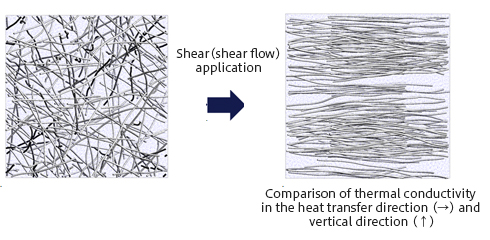- Continuum model
- Thermal
- Material Science
[Analysis Example] Simulation of heat transfer in fiber oriented material using VSOP-PS
Creation of fiber oriented structures and evaluation of thermal conductivity by particle method
Objectives and Methods
Thermal diffusion and dissipation using fiber-oriented materials, in which fibers are oriented in a matrix to provide anisotropic thermal conduction, are being studied (e.g., cellulose nanofibers + carbon fibers1 and composite materials of resin + matrix + air bubbles2).
We have developed a case study to predict the thermal conductivity of a fiber oriented material by particle simulation.We calculated the thermal conductivity when fibers were oriented in the heat transfer direction and vertically, and investigated whether there were any differences. We also compared the results with Digimat-MF3 using the equivalent inclusion method.
Model
The matrix and fibers are modeled with particles. The shape of the fiber is slightly curved from a rigid shape by connecting the particles in a one-dimensional direction and giving interaction between them. The orientation structure is obtained by applying shear flow.
*The matrix in the figure is drawn as dots to make it easier to see the fibers. In reality, the matrix fills in around the fibers.
| Density of matrix: | 1.08[g/cm3] |
|---|---|
| Specific heat of matrix: | 1340[J/(kg・K)] |
| Thermal conductivity of matrix: | 0.2[W/mK] |
| Density of fiber: | 1.5[g/cm3] |
| Specific heat of fiber: | 1880[J/(kg・K)] |
| Thermal conductivity of fiber: | 20.0[W/mK] |
| Weight percent concentration of fiber: | 10.0[wt%] |
Calculation time: approx. 12-16 minutes (8 cpu)
 .
.
Result
The thermal conductivities of oriented fibers (0°) and vertically oriented fibers (90°) were calculated and compared using VSOP-PS. The thermal conductivity in the oriented fiber direction was about 3 times larger than that in the perpendicular direction. The results of Digimat-MF(shown in the lower right figure) showed the similar trend.
By combining shear (shear flow) and thermal conductivity calculations in VSOP-PS, it is possible to evaluate the thermal conductivity properties of additives with various shapes and orientation directions.
 .
.


